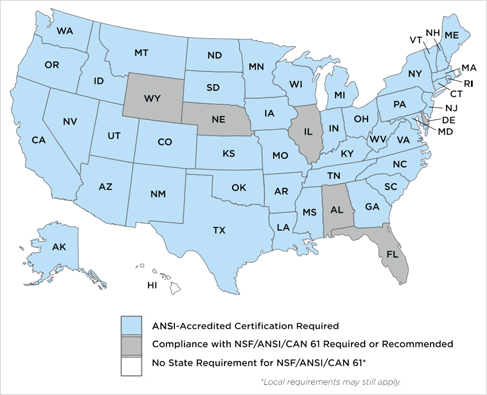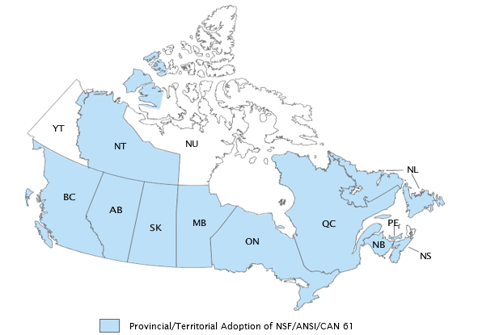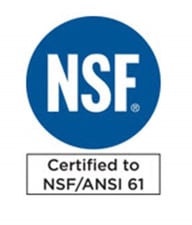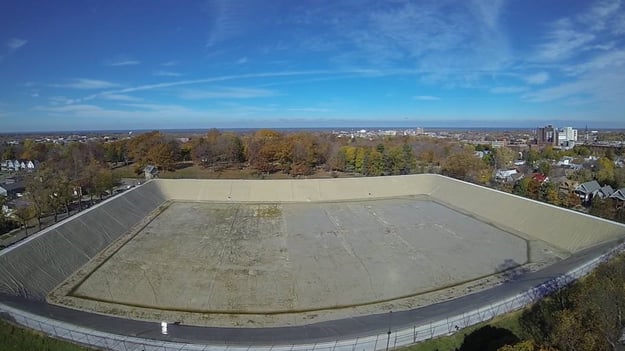The quality of the water we drink is pretty important. We assume we are protected by regulations that maintain high standards in our water, especially with the increasing use of geomembranes in potable water applications. But do all geomembranes comply? This blog will look at drinking water standards as they apply to geomembranes and how compliance should occur.
Drinking water quality in the U.S. is governed by the Safe Drinking Water Act, which was passed in 1974 and is administered by the Environmental Protection Agency (EPA). Prior to 1988, the EPA provided a regulatory framework for approval of products and components in drinking water and drinking water systems through its Additives Advisory Program. In 1984, competitive proposals were sought by the EPA for nongovernmental organizations to privatize the standards and approval process.
NSF International along with a consortium including the American Water Works Association (AWWA), the Association of State Drinking Water Administrators (ASDWA), and the Conference of State Health and Environmental Managers was awarded the contract to develop and maintain the standard. The consortium is generally referenced as “NSF,” which published the first edition of the standard in 1988. Subsequently, the EPA formally ended the Additives Advisory program in 1990.

Source: American National Standards Institute
NSF is accredited by the American National Standards Institute (ANSI) and the Standards Council of Canada (SCC). So the standard is usually designated as NSF/ANSI 61 or NSF/ANSI/CAN 61. Standard 60 covers water additives or chemicals. Standard 61 applies to equipment or surfaces that contact potable water from the entry of raw water into a treatment facility until the water enters private containment, such as piping across private property (service lines) or inside a building, where it is then governed by a different standard.
Rather than being a water quality standard, NSF/ANSI 61 seeks to measure chemicals that leach from the water contact material or surfaces—including geomembranes—into drinking water. There are more than 2,000 measured containments listed, with some measured at different pH levels and some other changes in each revision of the standard.
For instance, updates in 2019 and 2020—organics and lead included—required recertification of all products. Updates are likely when the EPA finalizes limits on perfluoroalkyl substances (PFASs). A testing protocol, along with acceptable limits, comprises the standard.
How to get drinking water certified.
The NSF/ANSI 61 certification process requires:
- Disclosure by the manufacturer of all water contact materials in the product.
- Disclosure by the manufacturer’s material suppliers of all chemical ingredients in the materials.
- NSF staff review of water contact materials to determine possible ingredients, contaminants or reaction byproducts that might leach from the material into drinking water.
- Chemical testing as dictated by data gathered.
- Facility inspection for product formulation, consistent raw materials and suppliers, process verification and quality control.
- Sample collection for testing.
- Chemical analysis for pass/fail criteria of NSF/ANSI 61.
- Unannounced annual production facility inspections and sampling for testing.
In addition to NSF’s certification program, other organizations are ANSI accredited and provide certification to the NSF/ANSI 61 standard. For example, the Water Quality Association provides an ANSI approved certification program similar to NSF with a similar process for certification to the standard.
Drinking water standards are state administered. As of April 2019, 49 states required ANSI-accredited certification or compliance with NSF/ANSI 61, as shown on the map below.
 Source: NSF and ASDWA
Source: NSF and ASDWA
In Canada, 11 of 13 provinces/territories require drinking water system components to comply with the requirements of NSF/ANSI/CAN 61. It is further noted however, that only five of the provinces indicate “SCC-Accredited Certification Required/Recommended.”

Source: NSF and ASDWA
What is the difference between NSF certification and NSC compliance?
Some states/provinces allow “compliance” rather than “certification.” Various manufacturers choose to claim NSF/ANSI 61 “compliance” rather than “certification.” This implies that NSF/ANSI 61 practices and testing are being followed, but there is no third-party verification and potentially no or incomplete data support. It would further appear in the industry that there is a lack of discernment between the significance of certification vs. compliance.

Even in the design community that is true. A recent conversation with a prominent design firm that specifies geomembranes for various potable water applications, including clearwell baffles and floating covers, could not identify the type of NSF/ANSI 61 certification for compliance claimed by the manufacturer’s products they specify. It is also notable that these products make no distinction between:
- Tested and certified by an ANSI certified organization.
- Certified by an ANSI certified organization.
- Compliant with NSF/ANSI 61 requirements.
Many geomembranes that are offered for potable water contact claim NSF/ANSI 61 certification but do not communicate how and by whom certification or compliance was determined. If a manufacturer self-certifies, they retain the option to change suppliers or raw materials at any time, which changes the “certified” or “compliant” product. If they rely on non-ANSI testing and/or compliance, the geomembrane is not certified to the NSF/ANSI 61 contact surface standard.
NSF certification by an ANSI-certified organization is expensive. It is expensive because it is thorough. Further, by obtaining and maintaining the certification, the water system owner, the consulting engineer, the state regulator and the geomembrane manufacturer have thoroughly complied with the most up-to-date drinking water safety standards. And it has been done by an independent, accredited third party.

Source: ASCE
Look closely at NSF 61 approvals. Don’t accept compliance only or lack of clarity in certification status and source. Specify geomembranes that are listed as being ANSI certified to the requirements of NSF 61 and publicly listed for verification.

8142 XR-5 PWR Geomembrane Floating Potable Water Cover. Erie, Pennsylvania, USA
Manufacturer: Seaman Corporation
NSF/ANSI/CAN 61 certified. Listing available here.
Learn more about geomembrane use in the potable water industry.



